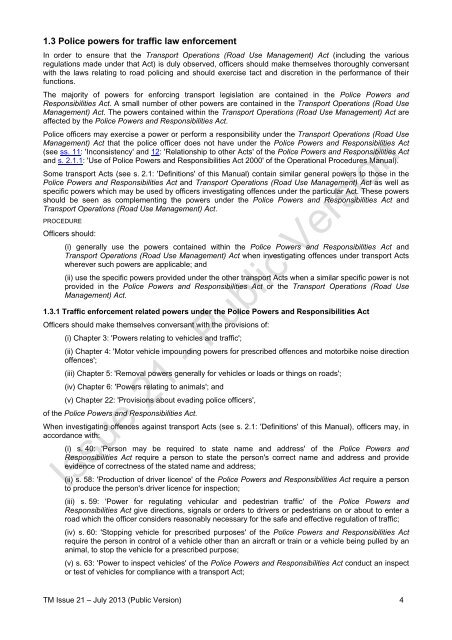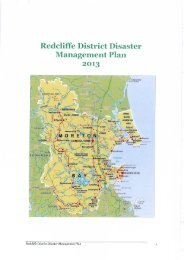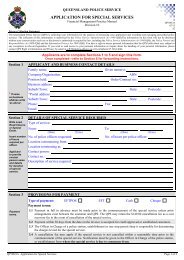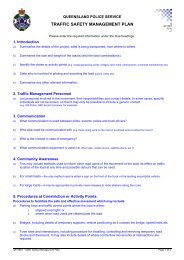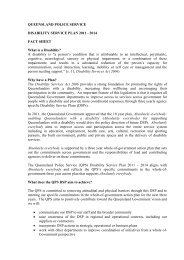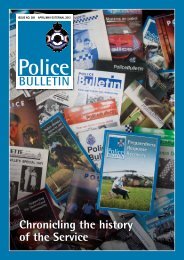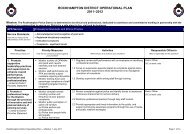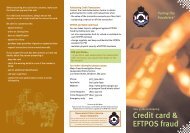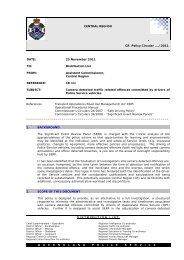Traffic Manual - Queensland Police Service
Traffic Manual - Queensland Police Service
Traffic Manual - Queensland Police Service
You also want an ePaper? Increase the reach of your titles
YUMPU automatically turns print PDFs into web optimized ePapers that Google loves.
1.3 <strong>Police</strong> powers for traffic law enforcement<br />
In order to ensure that the Transport Operations (Road Use Management) Act (including the various<br />
regulations made under that Act) is duly observed, officers should make themselves thoroughly conversant<br />
with the laws relating to road policing and should exercise tact and discretion in the performance of their<br />
functions.<br />
The majority of powers for enforcing transport legislation are contained in the <strong>Police</strong> Powers and<br />
Responsibilities Act. A small number of other powers are contained in the Transport Operations (Road Use<br />
Management) Act. The powers contained within the Transport Operations (Road Use Management) Act are<br />
affected by the <strong>Police</strong> Powers and Responsibilities Act.<br />
<strong>Police</strong> officers may exercise a power or perform a responsibility under the Transport Operations (Road Use<br />
Management) Act that the police officer does not have under the <strong>Police</strong> Powers and Responsibilities Act<br />
(see ss. 11: 'Inconsistency' and 12: 'Relationship to other Acts' of the <strong>Police</strong> Powers and Responsibilities Act<br />
and s. 2.1.1: 'Use of <strong>Police</strong> Powers and Responsibilities Act 2000' of the Operational Procedures <strong>Manual</strong>).<br />
Some transport Acts (see s. 2.1: 'Definitions' of this <strong>Manual</strong>) contain similar general powers to those in the<br />
<strong>Police</strong> Powers and Responsibilities Act and Transport Operations (Road Use Management) Act as well as<br />
specific powers which may be used by officers investigating offences under the particular Act. These powers<br />
should be seen as complementing the powers under the <strong>Police</strong> Powers and Responsibilities Act and<br />
Transport Operations (Road Use Management) Act.<br />
PROCEDURE<br />
Officers should:<br />
(i) generally use the powers contained within the <strong>Police</strong> Powers and Responsibilities Act and<br />
Transport Operations (Road Use Management) Act when investigating offences under transport Acts<br />
wherever such powers are applicable; and<br />
(ii) use the specific powers provided under the other transport Acts when a similar specific power is not<br />
provided in the <strong>Police</strong> Powers and Responsibilities Act or the Transport Operations (Road Use<br />
Management) Act.<br />
1.3.1 <strong>Traffic</strong> enforcement related powers under the <strong>Police</strong> Powers and Responsibilities Act<br />
Officers should make themselves conversant with the provisions of:<br />
(i) Chapter 3: 'Powers relating to vehicles and traffic';<br />
(ii) Chapter 4: 'Motor vehicle impounding powers for prescribed offences and motorbike noise direction<br />
offences';<br />
(iii) Chapter 5: 'Removal powers generally for vehicles or loads or things on roads';<br />
(iv) Chapter 6: 'Powers relating to animals'; and<br />
(v) Chapter 22: 'Provisions about evading police officers',<br />
of the <strong>Police</strong> Powers and Responsibilities Act.<br />
When investigating offences against transport Acts (see s. 2.1: 'Definitions' of this <strong>Manual</strong>), officers may, in<br />
accordance with:<br />
(i) s. 40: 'Person may be required to state name and address' of the <strong>Police</strong> Powers and<br />
Responsibilities Act require a person to state the person's correct name and address and provide<br />
evidence of correctness of the stated name and address;<br />
(ii) s. 58: 'Production of driver licence' of the <strong>Police</strong> Powers and Responsibilities Act require a person<br />
to produce the person's driver licence for inspection;<br />
(iii) s. 59: 'Power for regulating vehicular and pedestrian traffic' of the <strong>Police</strong> Powers and<br />
Responsibilities Act give directions, signals or orders to drivers or pedestrians on or about to enter a<br />
road which the officer considers reasonably necessary for the safe and effective regulation of traffic;<br />
(iv) s. 60: 'Stopping vehicle for prescribed purposes' of the <strong>Police</strong> Powers and Responsibilities Act<br />
require the person in control of a vehicle other than an aircraft or train or a vehicle being pulled by an<br />
animal, to stop the vehicle for a prescribed purpose;<br />
(v) s. 63: 'Power to inspect vehicles' of the <strong>Police</strong> Powers and Responsibilities Act conduct an inspect<br />
or test of vehicles for compliance with a transport Act;<br />
TM Issue 21 – July 2013 (Public Version) 4


